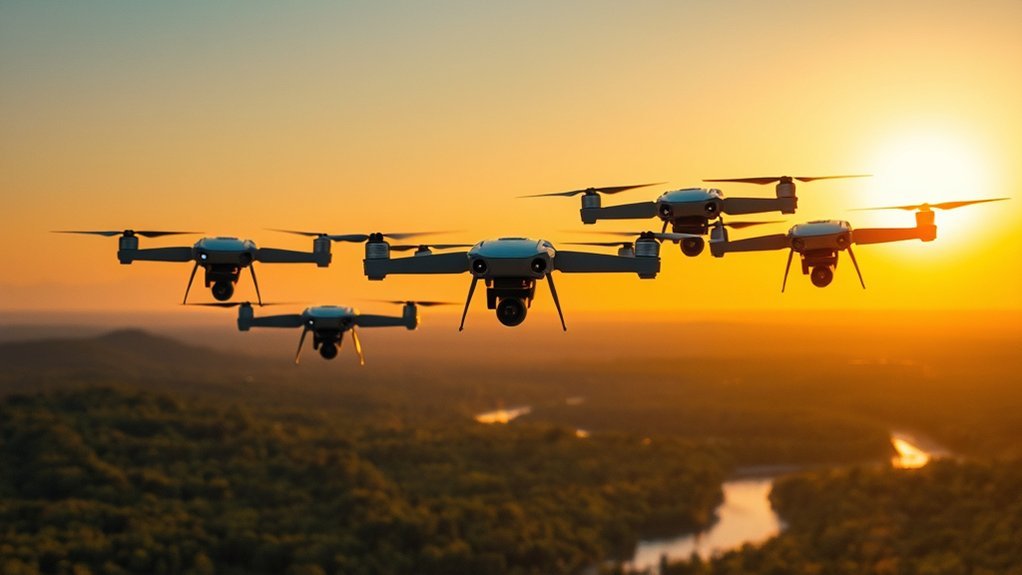Discover the best drones to elevate your videography in 2025. The DJI Mini 3 offers lightweight agility, while the Potensic ATOM SE provides exceptional portability. The Bwine F7GIM Pro impresses with its 6K UHD camera and extended flight time. For adults, the DJI Mini 3 RC packs advanced features in a compact frame. Finally, the Potensic Atom 2 delivers stunning 8K photos. With these options, you’ll capture stunning aerial footage like never before. Explore further for enchanting details.
DJI Mini 3 Lightweight Camera Drone with 4K Video & GPS Auto Return
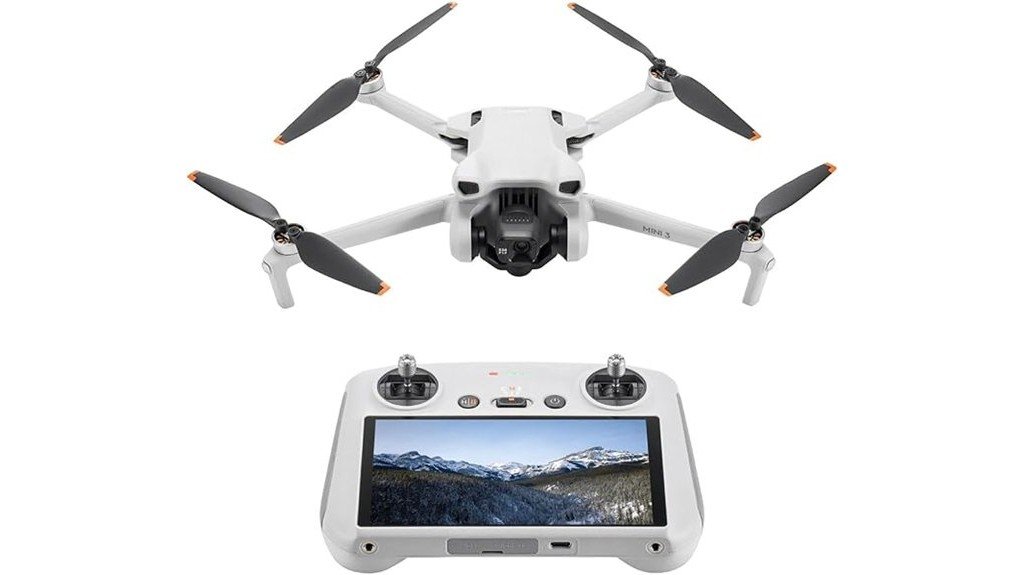
When you’re searching for the best drones for videography, the DJI Mini 3 Lightweight Camera Drone stands out, especially if portability and stunning video capabilities are high priorities for you. Weighing just 248 grams, it requires no registration in most regions. You’ll enjoy up to 38 minutes of flight with the Intelligent Flight Battery, or extend to 51 minutes with the optional Plus version. Its 4K HDR video and 48 MP stills guarantee excellent quality. With a 10 km HD video transmission range, you’re covered for distant shots. The 3-axis gimbal assures stability, even with Level 5 wind resistance, making it ideal for capturing smooth footage.
Best For: Videographers and travelers who prioritize portability and high-quality video capabilities.
Pros:
- Lightweight and compact design, ideal for travel.
- Exceptional 4K HDR video quality with 48 MP stills.
- Long flight time of up to 51 minutes with optional battery.
Cons:
- Lacks obstacle avoidance sensors, requiring manual tracking for safety.
- Intelligent Flight Battery Plus is sold separately.
- Requires activation through the DJI Fly App for operation.
Potensic ATOM SE GPS Drone with 4K Camera (Lightweight & Foldable)
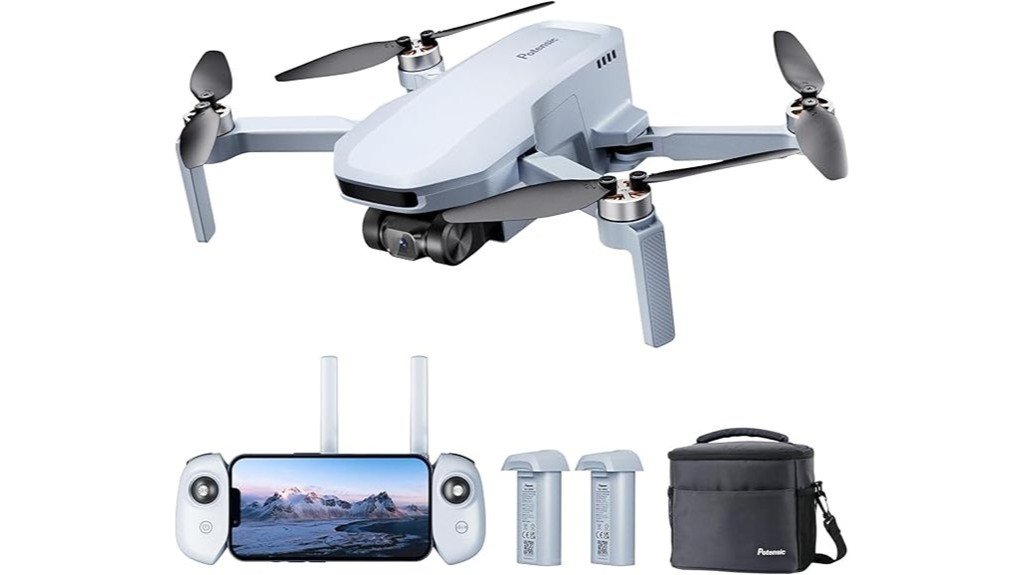
The Potensic ATOM SE GPS Drone is a top choice for videographers seeking a lightweight, foldable option without sacrificing quality. Weighing under 249g, this drone packs a punch with a 4K EIS camera and a 1/3” CMOS Sony Sensor, delivering stunning 12MP photos and 4K videos at 30fps. With a flight time of 62 minutes using two batteries, you’ll capture more footage without constant recharging. Its PixSync 2.0 guarantees stable video transmission, while the GPS-enabled auto return keeps your drone safe. Compatible with iOS and Android, it’s an excellent choice for capturing breathtaking aerial footage effortlessly.
Best For: Videographers and hobbyists looking for a lightweight, high-quality drone with advanced camera features and stable flight performance.
Pros:
- Lightweight and foldable design, making it easy to transport.
- High-resolution 4K camera with Electronic Image Stabilization for stunning footage.
- Long flight time of 62 minutes with two batteries, minimizing downtime.
Cons:
- Limited to a maximum speed of 16m/s, which may not be sufficient for all users.
- Requires compatible devices with iOS 11 or Android 7.0 or above.
- The standard Amazon return policy may not cover all potential issues.
Bwine F7GIM Pro Drone with 6K UHD Camera & GPS Smart Control
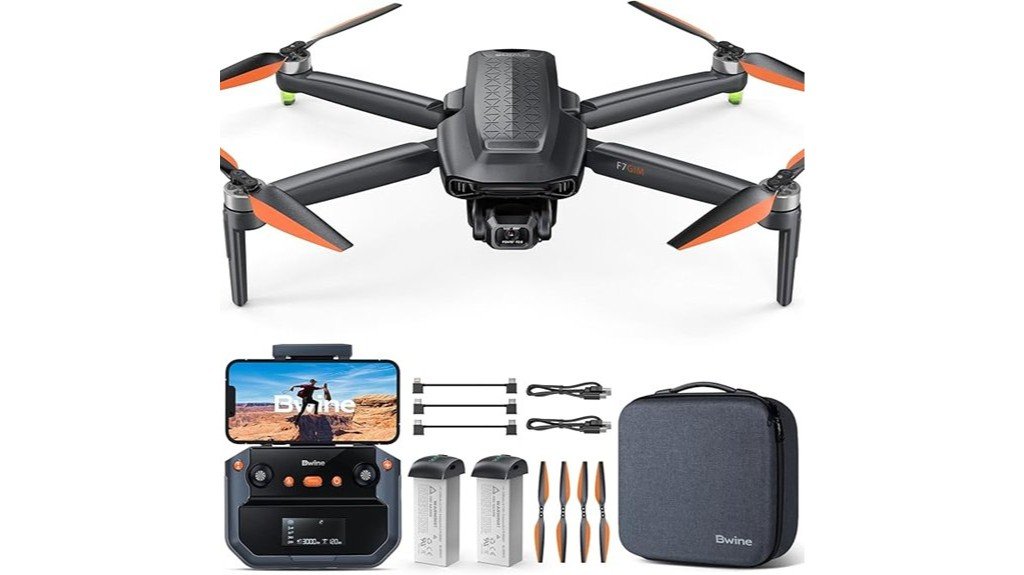
Looking for the best drone for your videography needs? The Bwine F7GIM Pro might just be the perfect fit. With a stunning 6K UHD camera and 4K/30fps video, you’ll capture breathtaking footage. The 3-axis brushless gimbal guarantees smooth shots, while the impressive 70-minute flight time lets you get the perfect angle without rushing. Its GPS smart control includes useful features like follow me and waypoint planning. Weighing just 357 grams and boasting a 10,000ft transmission range, it’s portable yet powerful. Plus, enjoy peace of mind with its intelligent return-to-home feature and lifetime warranty. This drone’s built for everything you need.
Best For: Professional videographers and drone enthusiasts seeking high-quality aerial footage with advanced GPS features and extended flight time.
Pros:
- Stunning 6K UHD camera with 4K/30fps video and 3-axis gimbal for smooth, high-quality footage.
- Remarkable 70-minute flight time, doubling the industry average.
- Comprehensive GPS smart control with features like follow me, waypoint planning, and orbit flight.
Cons:
- At 357 grams, it may require FAA registration for certain uses.
- Advanced features might present a learning curve for beginners.
- Premium price point may be higher than entry-level drones.
DJI Mini 3 Drone with Camera for Adults (DJI RC)
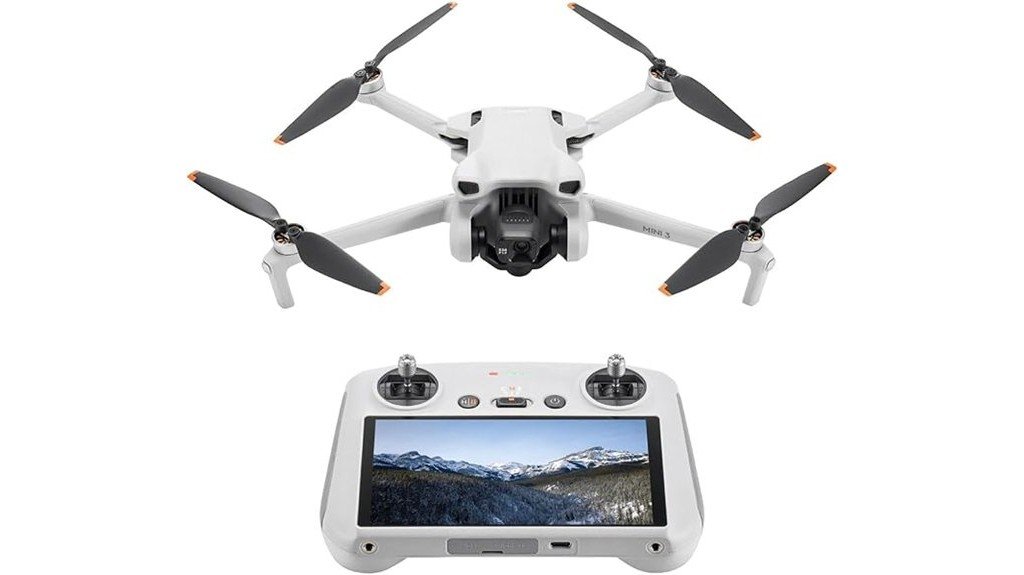
For videography enthusiasts seeking a versatile and user-friendly drone, the DJI Mini 3 Drone with Camera for Adults (DJI RC) stands out as a top choice. Weighing just 248 grams, it doesn’t require registration, making it convenient for travel. You’ll enjoy up to 38 minutes of flight time, or extend it to 51 minutes with the Intelligent Flight Battery Plus. Capture stunning 4K HDR video and 48 MP stills with ease. The 3-axis gimbal guarantees stable shots, even in windy conditions. With a range of 10 km, you’ll explore new perspectives effortlessly. Its compact design and user-friendly app make it perfect for any adventure.
Best For: Videography enthusiasts and travelers looking for a portable and user-friendly drone capable of capturing high-quality video and stills.
Pros:
- Lightweight design that does not require registration, making it travel-friendly.
- Impressive 4K HDR video and 48 MP still photo capabilities for stunning visuals.
- Long flight time of up to 51 minutes with an optional battery upgrade.
Cons:
- Lacks obstacle avoidance sensors, requiring manual tracking for safety.
- Intelligent Flight Battery Plus is sold separately, adding to the cost.
- Requires activation and usage through the DJI Fly App, which may limit compatibility with other apps.
Potensic Atom 2 Drone with 4K Camera & 3-Axis Gimbal (Fly More Combo)
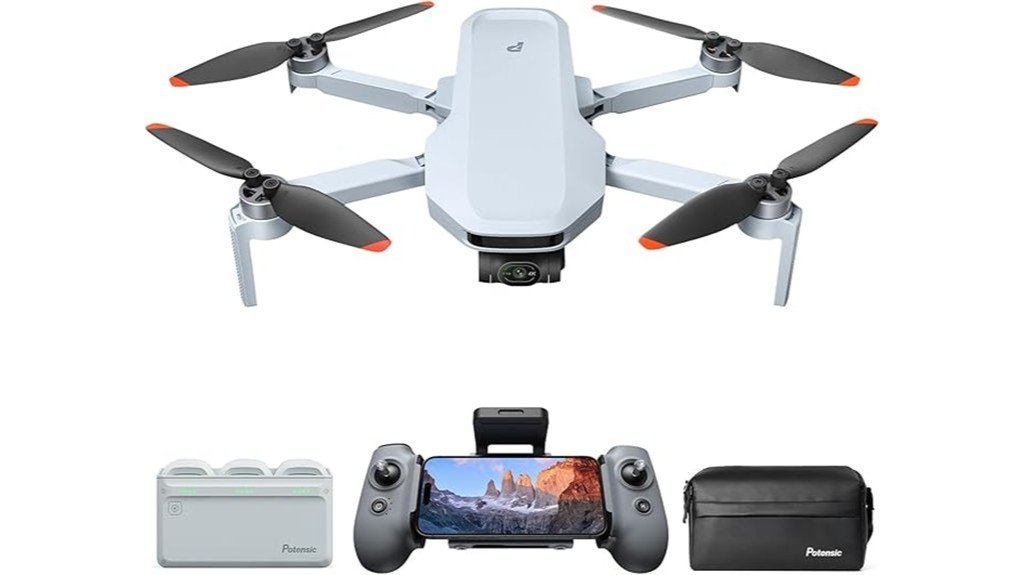
Capturing breathtaking cinematic shots has never been easier with the Potensic Atom 2 Drone with 4K Camera & 3-Axis Gimbal (Fly More Combo). You’ll love its 8K photo and 4K HDR video capabilities, thanks to the 1/2 Sony CMOS sensor. The F1.8 aperture guarantees excellent low-light performance, while the 3-axis gimbal keeps your footage stable. Its compact design, weighing under 249g, means no FAA registration hassle. Enjoy a 10 km control range and 96 minutes of flight with three batteries. Advanced AI features like object tracking enhance your videography, and Potensic Care offers instant support via the Potensic Eve app.
Best For: Photography enthusiasts and videographers looking for a portable drone with advanced features and excellent video and photo capabilities.
Pros:
- 8K photo and 4K HDR video quality with excellent low-light performance.
- Compact and lightweight design, eliminating the need for FAA registration.
- Extended flight time of 96 minutes with the Fly More Combo.
Cons:
- Requires a learning curve to master advanced features and controls.
- Limited to 4x digital zoom, which may not suffice for distant shots.
- May face connectivity issues in areas with signal interference.
Factors to Consider When Choosing a Drone for Videography
When picking a drone for videography, you’ll want to focus on a few key factors to guarantee you get the best results. Consider the importance of camera resolution and how it affects your video quality, along with the flight time, which determines how long you can capture footage. Don’t overlook stability and gimbal features, connectivity and range, or the portability and weight of the drone, as these elements greatly influence your shooting experience.
Camera Resolution Importance
While diving into drone videography, understanding the importance of camera resolution is vital for capturing stunning footage. High resolution, like 4K, offers four times the detail of 1080p HD, making your videos clearer and more vibrant. This is especially significant for large screens or when cropping during post-production. Effective still resolution, measured in megapixels, also impacts video quality. For instance, a 48 MP sensor lets you extract high-resolution stills from your footage. Dual Native ISO technology further enhances your camera’s performance, improving low-light conditions and reducing noise. Pairing high-resolution cameras with advanced stabilization, such as a 3-axis gimbal, guarantees smooth, professional-looking videos. These features collectively elevate your videography, allowing you to produce sharp, vivid, and stable aerial footage.
Flight Time Considerations
As you commence your drone videography journey, flight time becomes an essential consideration. Longer flight durations let you shoot continuously without frequent battery swaps. Many drones boast flight times from 30 to over 70 minutes, with options for extra batteries to keep you in the air longer. Keep in mind that a drone’s weight and battery type influence these times. Lighter drones often have better flight durations while staying portable.
Advanced battery management systems can improve battery efficiency, featuring smart controllers to prevent over-discharge. Also, consider the operating conditions. Factors like wind and temperature can greatly affect actual flight time. Choosing a drone with ideal flight time guarantees you capture the perfect footage without interruption, making your videography experience seamless and productive.
Stability and Gimbal Features
After considering flight time, focus on stability and gimbal features to guarantee your footage remains smooth and cinematic. A 3-axis mechanical gimbal is essential, as it compensates for pitch, roll, and yaw movements, ensuring your video stays steady. Look for drones with advanced stabilization technology, like brushless motors and Level 5 wind resistance, which help maintain stable flight even in challenging weather. Features such as ShakeVanish technology are designed to minimize vibrations, enhancing video quality. Adjustable camera angles, offering a vertical range from +20° to -90°, provide creative shooting possibilities. Additionally, stability features like TOF sensors contribute to low-altitude stability, reducing the risk of flyaways and enhancing safety, so you can focus on capturing stunning aerial footage without worry.
Connectivity and Range
When choosing a drone for videography, connectivity and range are essential factors that can greatly affect your filming experience. Strong Wi-Fi and Bluetooth connections guarantee seamless control and real-time video transmission to your device. A drone’s maximum control range is vital, with advanced models offering up to 10 kilometers (32,800 feet) for uninterrupted feeds. Look for drones with technologies like PixSync, which provide stable transmission, minimize lag, and maintain high-quality footage even at long distances. Good connectivity also allows easy software updates and access to additional features via mobile apps, enhancing your overall experience. Be aware of connectivity limitations, such as interference from obstacles or environmental factors, to effectively plan shoots and maintain control during flights.
Portability and Weight
Considering portability and weight is essential when choosing a drone for videography. Opt for models under 249 grams, as they often don’t need FAA registration, making travel and spontaneous shooting a breeze. A compact design is a must-have for easy transport in backpacks or carry-on luggage, perfect for videographers constantly on the move. Lightweight drones generally offer longer flight times because they consume less power, enabling you to capture more footage without frequent landings. Many of these drones also feature foldable designs, providing space-efficient storage without sacrificing camera quality or flight capabilities. While lighter drones can be more wind-sensitive, advanced stabilization technology often compensates for this, ensuring smooth, stable footage even in challenging conditions.
Frequently Asked Questions
What Are the Legal Requirements for Flying Drones in 2025?
In 2025, you must register your drone, pass a knowledge test, and follow altitude restrictions. Always maintain visual line-of-sight and avoid no-fly zones. Check local laws, as regulations vary by country and region. Stay informed!
How Do I Maintain and Care for My Drone’s Camera?
Clean your drone’s camera lens regularly with a microfiber cloth. Avoid harsh chemicals. Store it in a protective case when not in use. Check for firmware updates often to guarantee peak performance and prevent potential issues.
Are There Drones Specifically Designed for Low-Light Videography?
Yes, there are drones made for low-light videography. They use advanced sensors and algorithms to guarantee your footage shines like a diamond in the rough. You’ll capture crisp, clear images even when the sun’s gone down.
What Are Common Troubleshooting Tips for Drone Connectivity Issues?
Reset your drone and controller, ensuring they have updated firmware. Check for interference from nearby devices. Reposition to an open area. Rebind the controller if needed. Always keep your drone’s antennas properly aligned for ideal signal strength.
How Can I Extend the Battery Life of My Videography Drone?
To extend your drone’s battery life, reduce unnecessary weight, avoid full throttle, and use power-efficient settings. Monitor battery health, keep it cool, and charge partially when storing. Regular firmware updates can also optimize energy consumption.
